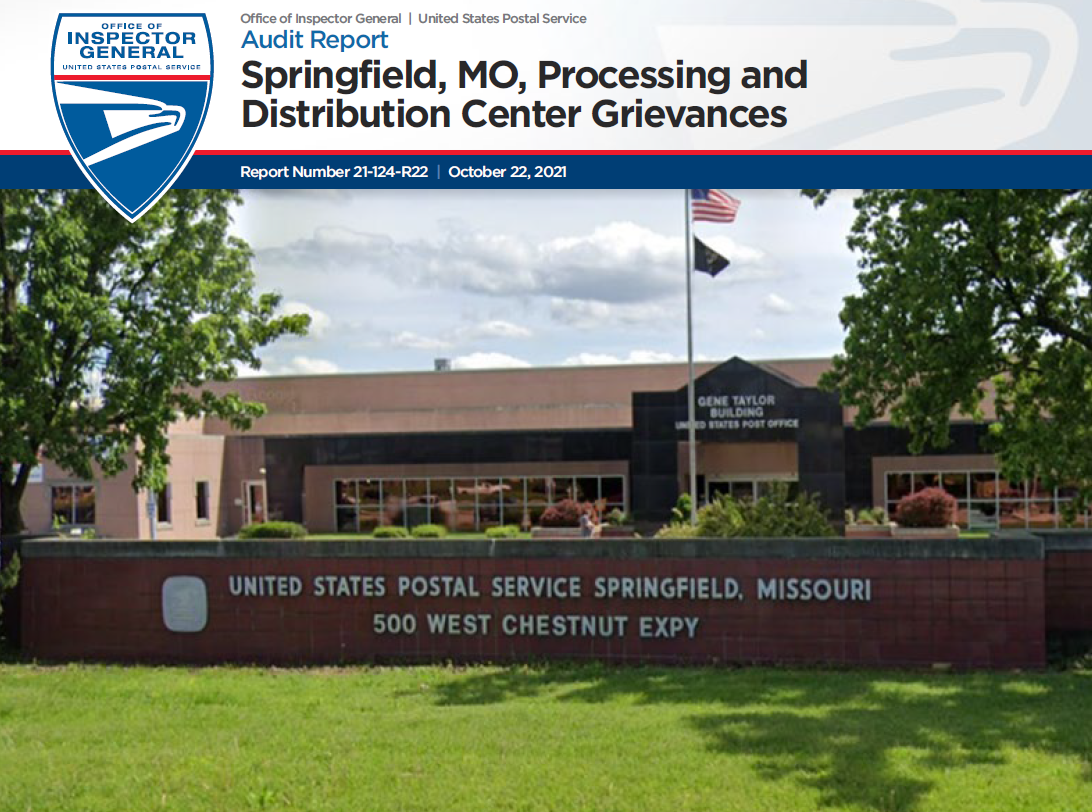
Objective
Our objective was to review and assess grievances paid from October 1, 2017, through March 31, 2021, at the Springfield, MO, Processing and Distribution Center (P&DC).
The Postal Service defines a grievance as a dispute, difference, or disagreement between parties or a complaint lodged by a party regarding wages, hours, or conditions of employment. A grievance includes, but is not limited to, an employee or union complaint involving the interpretation or application of or compliance with a collective bargaining agreement or any local memorandum of understanding not in conflict with the agreements. Monetary payments to employees are commonly used to resolve grievances.
Postal Service policy and collective bargaining agreements encourage resolution of work issues at the lowest levels, with discussions between bargaining unit employees and their immediate supervisor. The supervisor has the authority to settle grievances at any time; this part of the process is referred to as the informal grievance process, or Step 1. If there is no resolution at this step, the union can file a formal grievance. There are three stages in the formal grievance process: Step 2, Step 3, and arbitration. At Steps 2 and 3, the employee or union files an appeal to the next level of management.
Management uses the Grievance and Arbitration Tracking System to track grievances through the grievance process.
From October 1, 2017, through March 31, 2021, the Springfield P&DC paid [redacted] in total grievance payouts.
Findings
Postal Service management needs to improve the contentious workplace environment at the Springfield P&DC to successfully increase productivity and decrease grievances. Additionally, management needs to effectively manage and control the grievance process. The total annual grievance payouts and the annual average payment per grievance have continued to trend upward from fiscal year (FY) 2018 through FY 2020.
We found that the work environment in the Springfield P&DC negatively affected operations at the facility. In a statistical sampling of grievances with payouts and other supporting documentation from management, we identified multiple documented allegations of physical and verbal attacks resulting in employees regularly experiencing a hostile working environment.
Additionally, employees refusing to sign required forms or follow management’s verbal instructions further undermined operations.
We also found that management did not effectively manage and control the grievance process, resulting in payouts far exceeding those at comparable facilities. The Springfield P&DC’s FY 2020 total grievance payouts were [redacted] compared to the combined [redacted] at nine comparable facilities. The FY 2020 average grievance payout was [redacted] at the Springfield P&DC compared to the nationwide average of [redacted]. Specifically:
- Five employees received grievance payouts ranging from about [redacted] to over [redacted] per employee from October 1, 2017, through March 31, 2021.
- Management relied on an inefficient manual process to administer overtime. Overtime-related activity was the highest paid grievance issue identified, totaling [redacted], or 34 percent of the total grievance payments at the Springfield P&DC.
- Staffing and overtime grievances increased as bargaining employees’ regular workhours decreased and unscheduled leave and leave without pay increased from FY 2018 to FY 2020.
- While policy requires management to attempt to settle grievances at the lowest possible level in the grievance process, the Springfield P&DC paid 78 percent of grievance payouts at the initial step of the formal grievance process, compared to 34 percent nationwide.
These conditions occurred due to a variety of reasons, including management and Labor Relations’ assertion that the long-standing culture of distrust affected employees in the facility. This, coupled with a breakdown in communication among management, union representatives, and bargaining-unit employees, allowed the contentious workplace environment to continue.
Additionally, management and Labor Relations, in some cases, did not effectively manage and control the grievance process because they:
- Assigned two rotating management employees to handle informal grievances instead of requiring employees to file grievances with their immediate supervisor.
- Were reluctant, at the informal grievance process, to negotiate and settle grievance amounts or grievances they deemed too complicated.
- Were unaware of grievance policies, procedures, and documentation requirements. In part, this was due to insufficient grievance-specific training.
- Did not effectively use the Overtime Administration Application but instead used manual overtime desired list records.
A contentious work environment is destructive and detrimental to employees and substantially affects productivity and performance. Additionally, by not ensuring accurate and focused training on Postal Service policies and procedures, collective bargaining agreements and local memorandums of understanding, and by not using the Overtime Administration Application tool, there is increased risk of continued contract violations, more substantial grievance payouts, and less effective contract negotiations. We estimated the Postal Service incurred about $3.6 million annually due to lost productivity costs.
Recommendations
We recommended management:
- Conduct a formal workplace environment assessment (for example, an Initial Management Inquiry Process) and implement actions necessary to improve the contentious workplace environment at the Springfield P&DC.
- Instruct Springfield P&DC management to follow prescribed grievance procedures by ceasing the use of Step 1 designees in the informal grievance process for individual grievances and have employees or the union report informal grievances to the employee’s immediate supervisor in an attempt to settle grievances at the lowest possible step in the process.
- Develop a process to monitor compliance with grievance policies at the Springfield P&DC.
- Update local labor relations grievance training materials to include grievance timelines for the unions represented at the Springfield P&DC.
- Provide the mandatory Labor Relations Grievance Handling course to Springfield P&DC supervisors not in compliance with the training policy.
- Provide Springfield P&DC managers and supervisors of distribution operations training on the Overtime Administration Application and require use of the Overtime Administration Application at the facility.
Read full report
Source: Springfield, MO, Processing and Distribution Center Grievances | USPS Office of Inspector General
